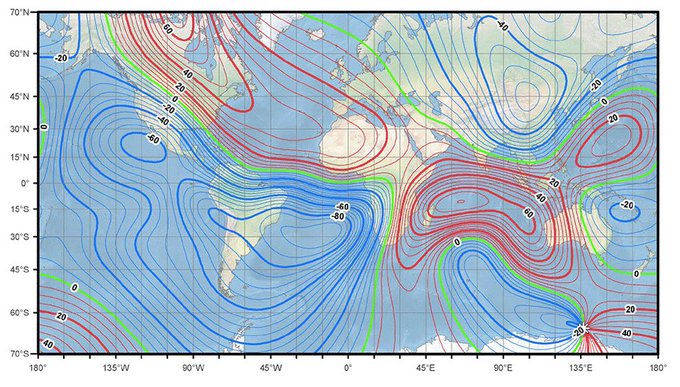What makes these recent changes so interesting is the sheer speed at which they are occurring.
Some fear that the rapid movement of the magnetic north pole could cause problems for Global Positioning Systems (GPS), military operations, airliners, and other navigation systems that rely on pinpointing where precisely the pole is located.
Migratory animals such as birds, butterflies, and whales also use the magnetic field for directions.
The latest report from NOAA, the “World Magnetic Model” for 2020, shows the pole rapidly speeding in the direction of Siberia. However, the trajectory of the pole will likely change.
NGA in partnership with @NOAA and the @BritGeoSurvey, has released the World Magnetic Model 2020 update, providing more precise navigational data for all military and civilian planes, ships, submarines and GPS units.
38 people are talking about this
This isn’t the first time that this has happened—polar wandering has been constant since the North Pole was first discovered, according to the National Oceanic and Atmospheric Administration (NOAA).
NOAA’s National Centres for Environmental Information explained:
“Since its first formal discovery in 1831, the north magnetic pole has travelled around 1,400 miles (2,250 km).
This wandering has been generally quite slow, allowing scientists to keep track of its position fairly easily.”
As recently as 2000, the magnetic North Pole was clocked at moving 6.2 miles per year toward Northern Russia, but data for the next two decades shows the average rate suddenly increasing to roughly 34 miles per year in the same direction, while the latest readings in 2019 show it slightly decreasing to about 31 miles per year.
The World Magnetic Model predicts the average speed will slow down to roughly 25 miles per year from 2020 to 2025.
“The WMM2020 forecasts that the northern magnetic pole will continue drifting toward Russia, although at a slowly decreasing speed—down to about 40 km per year compared to the average speed of 55 km over the past twenty years.”
For the first time in recorded history, the pole has even passed by the Greenwich meridian—the imaginary line used to indicate 0° longitude and determine time zones.
Geomagnetic specialist Ciaran Beggan from the British Geological Survey (BGS) told the Financial Times:
“The movement since the 1990s is much faster than at any time for at least four centuries.
We really don’t know much about the changes in the core that’s driving it.”
The team of researchers that maintain the World Magnetic Model has updated it and released it a year ahead of schedule. The newly updated model shows the magnetic north pole moving away from Canada and toward Siberia buff.ly/2PWlyh1
33 people are talking about this
Read More HERE





3 comments:
I'm sure the Solar Minimum has nothing to do with it.
Smart people are so stupid.
the movement of magnetic north may not be speeding up it may be that the instruments to track the movement are somewhat more accurate and sensitive than those instruments used two centuries ago
Post a Comment